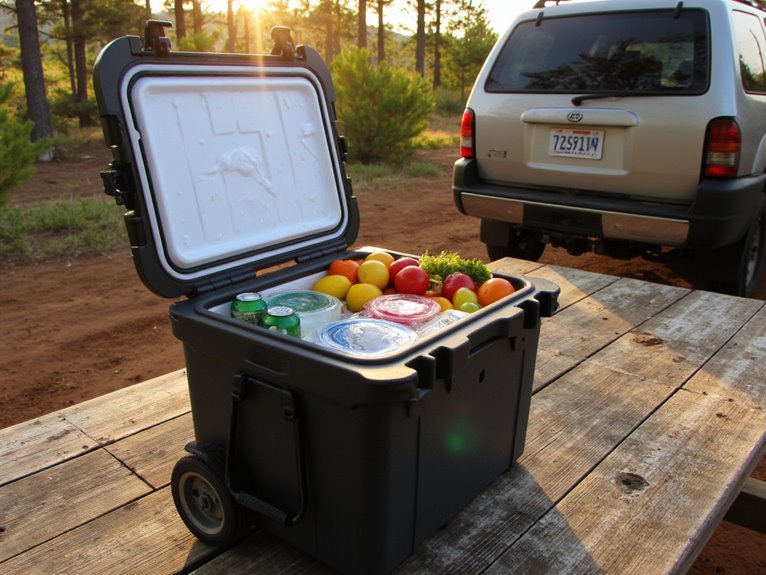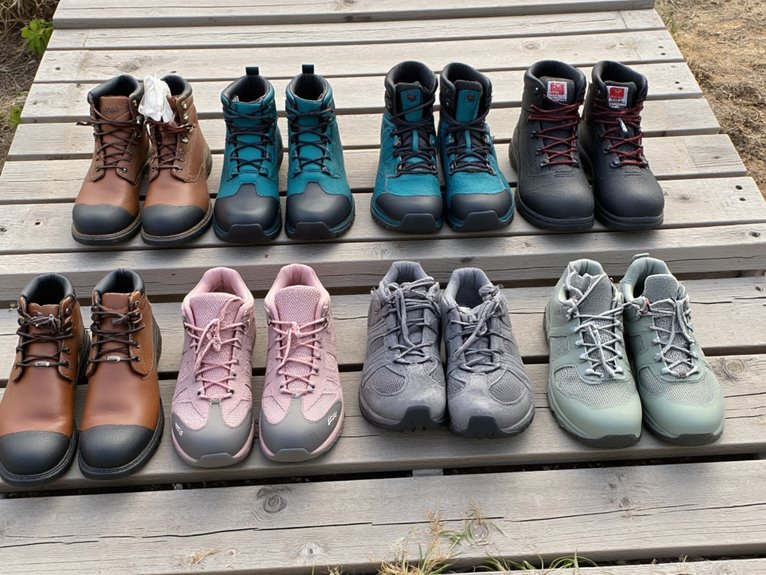How Do You Make a 30 Degree Sleeping Bag Warmer?
To make a 30-degree sleeping bag warmer, combine multiple strategies that focus on adding insulation, generating body heat, and utilizing external heat sources. Add insulating sleeping bag liners, thermal sleeping bag pads, or extra insulation layers to trap warm air and block cold air. Wear warm sleepwear to bed, stay active before bedtime, and eat a warm meal to generate body heat. Bring a hot water bottle or use a sleeping bag heater to supplement warmth. Additionally, modify your sleeping bag shell by re-treating the fabric or replacing damaged material to restore its integrity. Further refinements can substantially boost the sleeping bag's performance.
We are supported by our audience. When you purchase through links on our site, we may earn an affiliate commission, at no extra cost for you. Learn more. Last update on 18th December 2025 / Images from Amazon Product Advertising API.
Add Insulating Sleeping Bag Liners
By incorporating insulating sleeping bag liners, outdoor enthusiasts can significantly boost the thermal performance of their existing sleeping bags, effectively extending their comfort range in cold weather conditions.
These liners add an extra layer of insulation, trapping warm air and keeping the cold out. They are particularly useful for those who plan to camp in temperatures close to the sleeping bag's rated limit.
Insulating liners can increase the sleeping bag's temperature rating by 5-10°F, depending on the type and quality of the liner.
Look for liners made from materials like silk, fleece, or synthetic insulation, and choose a liner that fits snugly inside your sleeping bag to maximize its effectiveness.
Use Thermal Sleeping Bag Pads
Thermal sleeping bag pads provide an additional layer of insulation between the sleeping bag and the ground, effectively blocking cold air from seeping up from the ground and reducing heat loss.
This results in a warmer sleeping environment, especially in cold weather conditions.
By using a thermal sleeping bag pad, you can increase the overall warmth of your sleeping setup without having to upgrade your sleeping bag.
Look for pads with high R-values, which measure insulation performance, to maximize warmth.
Additionally, consider the pad's thickness, material, and compressibility when selecting the right one for your needs.
With a thermal sleeping bag pad, you can enjoy a cozier and more comfortable sleeping experience in cold temperatures.
Wear Warm Sleepwear to Bed
When considering wearing warm sleepwear to bed, the key is to prioritize materials and layers that provide ideal insulation.
By selecting the right fabrics, such as fleece, flannel, or silk, and combining them with strategic layering, you can create a warm and cozy sleeping environment.
In the following sections, we'll delve into the best warm sleepwear options, including the warmest pajama materials, insulating sock choices, and thermal base layers.
Warmest Pajama Materials
Wearing warm sleepwear to bed is a simple yet effective way to stay cozy throughout the night, and the type of fabric used in your pajamas can make all the difference.
Look for pajamas made from natural fibers like merino wool, fleece, or flannel, which provide excellent insulation and breathability.
Synthetic fabrics like polyester and nylon can also be effective, especially those with moisture-wicking properties.
Avoid cotton as it can absorb moisture and make you feel chilly.
Additionally, consider the thickness and weight of the fabric, as well as any special features like thermal lining or heat-trapping technology.
Insulating Sock Options
In addition to selecting the right pajama material, donning insulating socks can further amplify the warming effect, allowing you to stay cozy even in a chilly sleeping bag. Insulating socks can make a significant difference in retaining body heat and keeping your feet warm.
Thermal Socks: Made from materials like fleece, wool, or synthetic fabrics, thermal socks provide excellent insulation and moisture-wicking properties.
Heated Socks: Battery-powered heated socks can be a game-changer for extremely cold nights, providing a continuous flow of warmth to your feet.
Fleece-Lined Socks: These socks feature a soft, plush fleece lining that traps warm air and keeps your feet cozy and toasty.
Thermal Base Layers
Thermal base layers, consisting of long-sleeved tops and leggings, can be worn as warm sleepwear to bed, serving as an additional layer of insulation against the cold.
These layers trap warm air close to the body, reducing heat loss and keeping you cozy.
Look for moisture-wicking fabrics like merino wool, fleece, or synthetic blends that provide excellent thermal insulation.
Choose a snug fit to prevent cold air from entering, and opt for a breathable fabric to prevent overheating.
Wearing thermal base layers to bed can make a significant difference in keeping you warm, especially when combined with other methods to boost the warmth of your 30-degree sleeping bag.
Stay Active Before Bedtime
Engaging in physical activity before bedtime can have a profound impact on your body's temperature regulation during sleep.
By incorporating a pre-bed exercise routine, you can stimulate your metabolism and generate body heat that will last long after you've drifted off to sleep.
This approach can be particularly effective when combined with other sleep-conducive practices, such as wearing warm sleepwear to bed.
Pre-Bed Exercise Routine
Regular exercise, particularly in the evening, can actually promote a warmer sleeping bag by increasing body heat and preparing the body for a restful night's sleep.
Engaging in physical activity before bed can help raise your core temperature, which can be retained for a short period, keeping you warmer in your sleeping bag.
Perform light cardio exercises like jumping jacks, jogging in place, or cycling for 10-15 minutes.
Incorporate strength training exercises like push-ups, squats, or lunges to get your heart rate up.
Try some dynamic stretches like leg swings, arm circles, or torso twists to loosen up your muscles.
Boost Metabolism Before Sleep
To further amplify the warmth-retaining benefits of exercise, incorporate activities that boost your metabolism before sleep, as a higher metabolic rate can help generate more body heat during the night.
Engage in light to moderate-intensity aerobic exercises, such as jogging, cycling, or swimming, for at least 30 minutes before bedtime.
Alternatively, incorporate strength training exercises, like push-ups, squats, or lunges, to increase your metabolic rate.
These exercises will help boost your body's energy expenditure, leading to increased heat production during sleep.
Aim to finish your exercise routine at least 1-2 hours before bedtime to allow your body to wind down and relax before sleep.
Eat a Warm Meal Before Bed
A warm meal before bedtime can help increase your body's core temperature, making you feel cozier and preparing your body for a restful night's sleep. This is especially important when sleeping in a 30-degree sleeping bag.
A warm meal can raise your body's core temperature, which can help you stay warm throughout the night.
Some warm meal options worth exploring include:
- Hearty soups like beef stew or chicken noodle soup
- Warm oatmeal with nuts and dried fruits
- Grilled cheese sandwiches with tomato soup for dipping
Bring a Hot Water Bottle
By incorporating a hot water bottle into your sleeping setup, you can maintain a consistent and soothing warmth throughout the night.
This simple yet effective technique can notably improve the overall warmth of your 30-degree sleeping bag.
Fill the hot water bottle with warm water, not boiling, to avoid discomfort or burns.
Place the bottle near your feet or torso, depending on your personal preference, to radiate warmth.
The hot water bottle will slowly release heat, keeping you cozy and comfortable throughout the night.
This method is especially useful for cold sleepers or those who tend to feel chilly in the early morning hours.
Use a Sleeping Bag Heater
One effective way to amplify the warmth of your sleeping bag is to incorporate a sleeping bag heater, a specifically designed device that distributes heat evenly throughout the bag. This innovative solution ensures a consistent and comfortable sleeping temperature, even in chilly conditions.
Sleeping bag heaters are compact, lightweight, and energy-efficient, making them perfect for camping trips or backpacking adventures.
They are often rechargeable via USB, providing a convenient and eco-friendly option for campers.
Look for heaters with multiple heat settings and a built-in thermostat for optimal temperature control.
Add Extra Insulation Layers
Wrapped around the sleeping bag, extra insulation layers can substantially boost its warmth retention, making it an effective way to improve the bag's thermal performance.
These layers can be in the form of insulating jackets, sleeping bag liners, or even emergency blankets.
When choosing an insulation layer, consider the material's R-value, which measures its thermal resistance. Look for layers with high R-values to maximize warmth.
Additionally, consider the layer's breathability to prevent moisture buildup. Properly fitted layers will ensure optimal performance.
Modify Your Sleeping Bag Shell
How can you breathe new life into your sleeping bag's worn-out shell to make it warmer and more efficient? A well-maintained shell can greatly impact the overall performance of your sleeping bag.
Re-treat the shell with a waterproofing agent: Restore the water-repellent properties of your shell to prevent moisture from seeping in and reducing insulation performance.
Apply a shell coating for added warmth: Add a thin, breathable coating to the shell to increase warmth retention and reduce heat loss.
Replace damaged or worn-out shell fabric: Swap out damaged areas with new, high-quality fabric to restore the shell's integrity and prevent cold spots.


